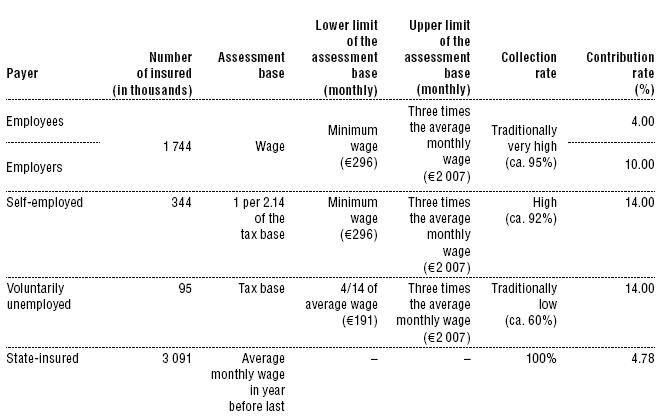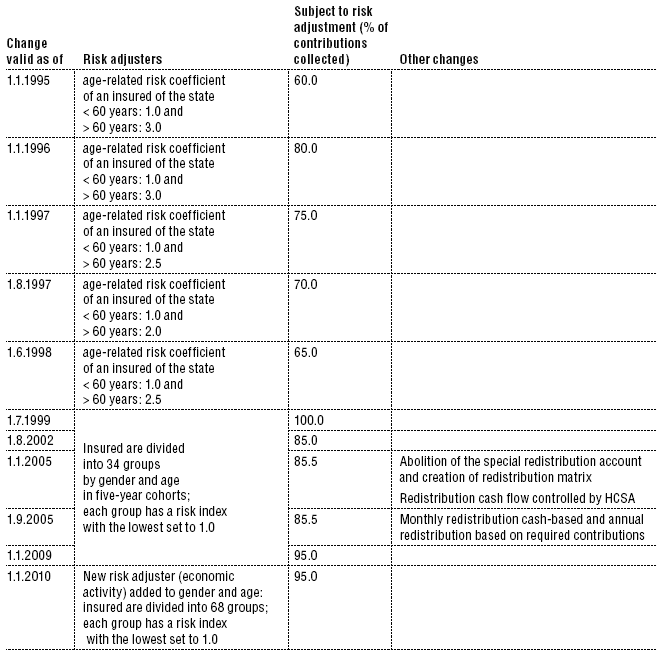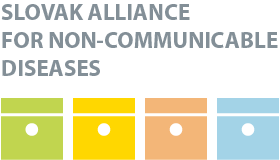—
HPI Network > HPI - Health Policy Institute > Health System in Slovakia > 3. Financing > 3.3 Overview of the statutory financing system
3.3 Overview of the statutory financing system
Thursday, 05. May 2011, 0:47 — HPI
| << PREVIOUS
3.2 Sources of revenue and financial flows |
Introduction – Organization – Financing – Resources – Provision – Reforms – Assessment – Conclusions – Appendices |
NEXT >>
3.4 Out-of-pocket payments |
- 3.3.1 Coverage
- 3.3.2 Collection
- 3.3.3 Pooling of funds
- 3.3.4 Purchasing and purchaser–provider relations
3.3.1 Coverage
Breadth: who is covered?
All residents in Slovakia are entitled to SHI, with the exception of people with health insurance in another state, which may be related to their job, business or long-term residence. The number of insured (5.274 million) is different from the number of inhabitants (5.405 million) because of a number of Slovak citizens who are insured in other EU Member States (approximately 131 000). People seeking asylum and foreigners who are employed, studying or doing business in Slovakia are also covered by SHI. Those insured are entitled to health care services according to conditions set forth in legislation. Every citizen has an equal right to have his or her needs met, regardless of his or her social position or income. The SHI system is universal, based on solidarity, and guarantees free choice of health insurance company for every insured. A health insurance company can reject a patient only if he or she applied for health insurance at several health insurance companies at the same time. In such cases, the valid application is the one submitted first.
Submitting an application to a health insurance company is the basic obligation of every SHI insured person. After an application has been submitted and acknowledged, a legal relationship between the applicant and the health insurance company is established. An insured person may opt for another health insurance company once a year, as of 1 January. The application should be submitted to the health insurance company by 30 September of the previous calendar year. The application is validated by the HCSA. Payment of contributions is a condition for receiving health care benefits based on SHI. With the exception of the “state-insured”, whose contributions are paid by the state, all insured are obliged to make monthly advance payments and to settle any outstanding balance on their total SHI contribution annually. If this obligation is violated, the insured are entitled only to urgent care and the health insurance company may require reimbursement of the costs.
Scope: what is covered?
The range of benefits available to individuals covered by SHI in Slovakia is broad. The Slovak Constitution guarantees every citizen health care under the SHI system according to the conditions laid down by law. The law outlines a list of free preventive care examinations; a list of anatomic therapeutic chemical (ATC) groups of essential pharmaceuticals without co-payment; a list of diagnoses eligible for free spa treatment; and a list of priority diagnoses (two-thirds of ICD-10 diagnoses). All health procedures provided to treat a priority diagnosis should be provided free. Non-priority diseases may be subject to co-payments. Until now (2010) procedures for treatment of almost all non-priority diseases are also without co-payment. Services upon a patient’s request and not based on his/her health needs are not covered. The Ministry of Health issues a positive list of reimbursed pharmaceuticals and medical aids each quarter. It sets the conditions of reimbursement and reimbursement level. Approximately one-third of the pharmaceuticals on the list are without co-payment. The decision is made by the Reimbursement Committee based on a set of criteria (for more detailed information see section 2.8.4 Regulation and governance of pharmaceuticals).
Depth: how much of the benefit cost is covered?
In the Slovak health system, the introduction of formal cost-sharing in 2003 has noticeably reduced the depth of the coverage. Cost-sharing mainly takes place through a system of small user fees for prescriptions and certain health services (for example, emergency care) as well as co-payments for pharmaceuticals and spa treatments. A reform in 2006 reduced some of the user fees and in some cases abolished them completely. See section 3.4 for more detailed information.
3.3.2 Collection
The SHI system is financed through a combination of contributions from the economically active population and state contributions on behalf of the non-economically active population (“state-insured”). SHI resources include (1) contributions from employees and employers, (2) contributions from self-employed people, (3) contributions from voluntarily unemployed (self-payers) and (4) contributions by the state for the “state-insured”. Contributions are collected and administered by health insurance companies.
The SHI contribution is calculated as the product of the insurance contribution rate defined by law and the assessment base. An overview is provided in Table 3.5. The contribution rate for economically active people is 14 %, with employees paying a 4% share and employers a 10% share. The contribution rate for people with severe disabilities is set at 7%, with employees paying a 2% share and employers a 5% share.
The annual assessment base is a sum of specified incomes, mainly related to work (excluding capital and other income). The Insurance Act sets limits to the contribution burden by defining minimum and maximum limits of the assessment base. The minimum assessment base is set at the monthly minimum wage (€296 in 2010). The maximum annual assessment base is three times the monthly national average wage (€2007 in 2010). Also the self-employed have to pay contributions at least from the minimum base, even if they have suffered losses in a particular year. However, their assessment base is calculated as 1 per 2.14 or 46.7% of their taxable income with the same maximum assessment base as employees have. For the voluntarily unemployed (self-payers), the minimum base is 4/14 of the average wage (€191 in 2010).
SHI contributions paid by the state are subject to a separate regulation. In 2010, the contribution rate is set at 4.78% with the national average wage as assessment base. At the beginning of the health reform in 2002–2006, the contribution rate was 4%, and since 2006 it has been rising continuously, reaching 4.9% in 2009. This contribution is paid on behalf of all those who are state-insured. The state contributions based on the average wage replaced arbitrary payments from general taxes.
Table 3.5: SHI contributions in the health insurance system, 2010

3.3.3 Pooling of funds
Contributions are collected directly by health insurance companies from employers, the self-employed, self-payers (voluntarily unemployed) and the state. The distribution of revenues and expenditures among the health insurance companies is unequal due to the different structure of their insured populations. To alleviate the financial burden on health insurance companies with a higher-risk portfolio and to reduce the potential for risk selection, SHI contributions are redistributed among the health insurance companies using a risk adjustment scheme.
Between 1995 and 2004, there was an internal system of risk adjustment, which was administered by the state-owned General Health Insurance Fund using a special “central redistribution account”. Since it was administered by the General Health Insurance Fund, which was also responsible for the central register of insured, it was frequently criticized on the grounds that its decisionmaking was not independent. Until 2004 it was quite common for health insurance funds not to pay into the central account, without any consequences such as licence withdrawal or limitation of their activities.
With the 2004 reform, the internal risk-adjustment scheme was replaced with an external risk-adjustment system supervised by the HCSA. The HCSA also became responsible for administering the central register of insured. Using risk adjusters, the receivable–payable relations between health insurance funds are calculated. As a result, each health insurance company knows which health insurance company is the debtor and which health insurance company is the creditor.
As of 2009, 95% of the contributions are subject to risk adjustment. This is to motivate the health insurance companies to increase their level of collected contributions (for example from defaulters). Risk adjustment is performed on a monthly basis and is accounted annually.
Until 2009, the redistribution system took only two demographic risk adjusters into account – age and gender of the insured. However, evidence shows that age and gender predict less than 5% of health care costs variability in Slovakia. In January 2010, a new risk adjuster was added to the redistribution mechanism. The age- and gender-related risk index is defined separately for the state-insured and insured people for whom the state does not pay contributions. The state-insured are legally defined in a heterogeneous list of individuals of widely diverging social status and different needs for health care services. This could make certain subgroups more attractive (for example students) than others (for example unemployed). Thus, this new risk adjuster may increase the incentive for risk selection (Szalay, 2008). Although efforts by health insurance companies to focus their marketing communication on selected target groups were observed in the past, analysis of insured mobility does not confirm the effectiveness of such efforts (Pažitný et al., 2008).
After several changes (see Table 3.6), the risk-adjustment system as of 2010 works as follows:
- Insured are divided into groups by age (five-year cohorts), 1. gender and economic activity. There are 68 groups of insured altogether.
- Each insured is assigned a risk index according to his/her risk group. This equals the proportion of average costs of one insured in a given group to the average costs of one insured in the group with the lowest costs.
- Subsequently, each insured is weighted using his/her risk index, which results in a standardized insured. The total sum of all standardized insured is calculated as the sum of products of insured and their risk index across all 68 groups.
- Standardized income from redistribution of one standardized insured is calculated as follows: redistributed resources (95% of all contributions) divided by the number of all standardized insured.
- The volume of resources from redistribution for each health insurance company is calculated as a product of the number of standardized insured and the contribution from redistribution per one standardized insured.
- Subsequently a redistribution matrix is created, which determines for each health insurance company the amount payable to or receivable from other health insurance companies.
Table 3.6: Changes to risk adjustment in the period 1995–2010

The General Health Insurance Company is the biggest recipient of redistribution resources. Since it was the only insurer on the market in 1994, historically it has an over-representation of the elderly. When new health insurance companies entered the market, it was generally the younger (healthier) people who switched health insurance companies.
3.3.4 Purchasing and purchaser–provider relations
Health care purchasing is based on selective contracting. This means that health insurance companies may have different contracts with different providers and that providers may have different contracts with different health insurance companies. Apart from state-owned hospitals, emergency services, GPs and pharmacies, health care providers are not implicitly entitled to have a contract with a health insurance company. The quality and price, and thus maintaining minimum accessibility of health care, are the determining criteria when contracting providers. The HCSA is in charge of monitoring the purchasing of health care services (see also section 2.8.1 Regulation and governance of third-party payers).
The contractual parties settle on conditions in the contract, including the scope and price of health services. The prices of health services are mostly freely negotiable. Health care providers enter into a contract directly with health insurance companies. The contracts are concluded for a period of one year, in accordance with the minimum contract duration set by law. To assure a minimum network of providers, health insurance companies must contract a minimum number of outpatient providers and a minimum volume of bed capacity in different self-governing regions. In 2007, the state strengthened its role in health care by adjusting the definition of a minimum network. An obligation of health insurance companies to contract all state hospitals, without meeting quality and effectiveness criteria, was laid down in a government regulation.
If the contracted limit is exceeded, the services performed by health care providers are not reimbursed by health insurance companies. In 2007, the difference between actual services delivered and reimbursed services mounted to €69 million, that is, 2.43% of total services delivered in 2007 (HCSA, 2008). Once every nine months, the health insurance companies must publish the contract requirements for health care providers in terms of technical equipment, personnel and quality indicators. The latter are defined by the Ministry of Health. Every six months, the health insurance company must also publish price offers from competing providers who have met their contract requirements. As of 31 December each year, the rating of providers, according to which the contracts are concluded by the health insurance company involved, is updated.
Health insurance companies present draft contracts to health care providers. Professional organizations take part in most of the negotiations on contractual conditions, but they rarely have an authorization from their members to negotiate on their behalf. The framework agreement is therefore more a recommendation than an obligation, setting only a minimum tariff and volume.
Some professional organizations negotiate contracts with health insurance companies on behalf of their members. Examples include the Zdravita association of outpatient physicians, which negotiates on behalf of approximately 1800 members, and the Slovak Medical Chamber, which negotiates on behalf of approximately 100 of its 18 000 members. The negotiated tariffs in the contract are shared by all members. The volume of health services is individually negotiated. These volumes are based on historic performance of the health care provider involved. If an association member is not satisfied with the contract volumes, he or she may negotiate directly with the health insurance company, supported by a representative of the association.
Possible disagreement on contracts is not specifically addressed in legislation. Health care providers are motivated to negotiate a contract or risk ending up empty-handed. Health insurance companies, in turn, need to contract in order to fulfil the minimum network requirement.
According to the HCSA, there is a significant difference in average prices between university (state-owned) and general (mostly non-state) hospitals, ranging between 30% and 104%. This difference does not correspond with the difference in difficulty and complexity of care according to a case-mix index (Pažitný, 2008).
News
The amendment of the Decree on emergency medical service
Health insurance companies returned over 400 thousand €
The HCSA received 1,647 complaints last year
A half million people will earn more
Most of public limited companies ended in the black
Debt of hospitals on premiums has grown to nearly € 105 MM
Slovak health care may miss € 250 million next year
Profits of HIC amounted to € 69 mil. last year
Owners of Dôvera paid out money but did not paid taxes
Like us on Facebook!
Our analyses
- 10 Years of Health Care Reform
- New University Hospital in Bratislava
- Understanding informal patient payments in Kosovo’s healthcare system
- Analysis of waiting times 2013
- Health Policy Basic Frameworks 2014-2016
- Analysis of informal payments in the health sector in Slovakia
- Serbia: Brief health system review
developed by enscope, s.r.o.
